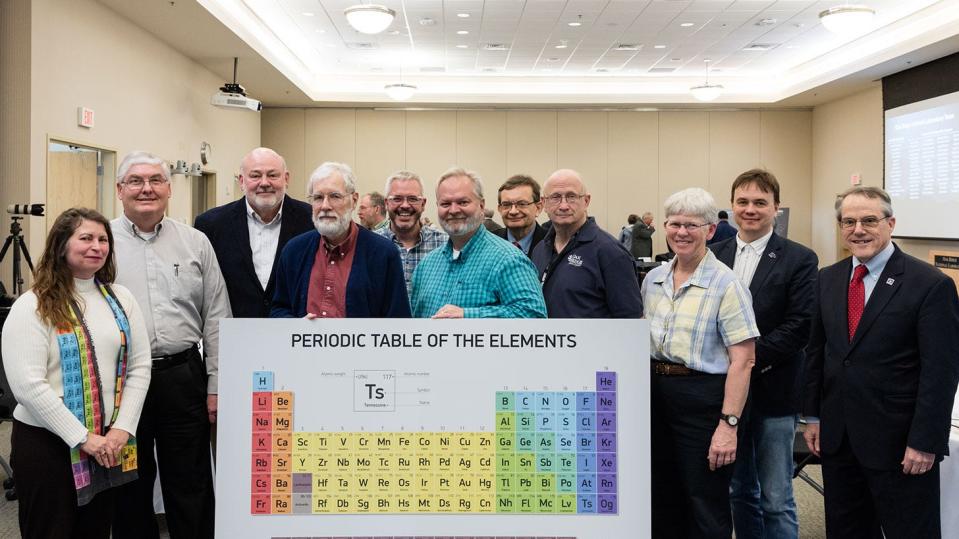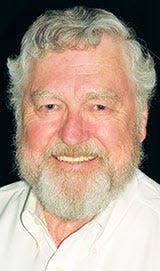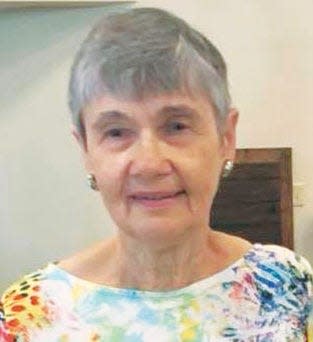The discovery of tennessine and the prospect of creating heavier elements
- Oops!Something went wrong.Please try again later.
Carolyn Krause presents Jim Roberto’s story about how element 117 named tennessine was discovered and what he thinks are the prospects of, and obstacles to, creating elements 119 and 120 and even heavier elements that could exist in “the island of stability.” He gave the brief history to an Oak Ridge Institute for Continued Learning (ORICL) class last fall.
This is the third part of a three-part series.
Oak Ridge National Laboratory credited with discovery of 3 elements in the periodic table
Nine elements on periodic table have been discovered using Oak Ridge National Lab isotopes
***

In 2004, Alex Zucker, a retired physicist who had served as acting director of and associate laboratory director at Oak Ridge National Laboratory, received a letter from Yuri Oganessian. This well-known Armenian Russian researcher of superheavy chemical elements had pioneered a technique that enabled the synthesis of elements with 114 or more protons in each atomic nucleus.
Oganessian, now the scientific director of the Flerov Laboratory of Nuclear Reactions at the Joint Institute for Nuclear Research (JINR) in Dubna, Russia, had led the discovery of the heaviest known element in the periodic table, oganesson-118, which was named after him in 2006. He is the second person (after Nobel Laureate Glenn Seaborg - seaborgium) to have an element named for him during his lifetime.
Oganessian, who knew Zucker well, sent him a letter proposing that ORNL collaborate with JINR in an experiment to produce element 117, which was the only element missing from the seventh row of the periodic table. To create element 117, JINR, which was using its accelerator to bombard actinide targets with a beam of calcium ions, needed a target made of berkelium. The High Flux Isotope Reactor (HFIR) at ORNL was the only source of sufficient quantities of this transuranium element.
In 2004, Zucker referred the Oganessian’s request to an ORNL associate lab director, not to Jim Roberto, then deputy director of science and technology at the time.
“I never saw the letter, which I think got buried because of a misunderstanding about the possibilities of the collaboration,” Roberto told the ORICL class. “So, then Yuri contacted his friend Joe Hamilton, a distinguished professor of physics in the Nuclear Physics Department at Vanderbilt University. Joe contacted me in 2008 and then I became aware of the letter.
“I was going to visit Vanderbilt about that time for a celebration of Joe’s 50th anniversary as a faculty member. Yuri had planned to be there also for the celebration, so Joe arranged a lunch meeting between me and Yuri. That’s where the deal was made in December 2008 that ORNL would provide the berkelium target material and collaborate with the accelerator research facility in Dubna for the attempt to produce atoms of element 117.
“To keep the cost down for this joint project, ORNL staff at HFIR could piggyback off the planned production of californium for our customers from which berkelium could be separated. We were able to fund it internally through the LDRD (Laboratory Directed Research and Development) program at ORNL and we also got funding from Lawrence Livermore National Laboratory (LLNL), which joined the team to assist with nuclear data analysis.”
The berkelium-249 needed for the Russian experiment was produced in an intermediate step in the normal production run of californium-252 in HFIR. The process involved 250 days of irradiation of curium and americium isotopes with neutrons at HFIR. In addition, the berkelium and californium were chemically separated by a 90-day process at the adjoining Radiochemical Engineering and Development Center.
“During this production run,” Roberto said, “HFIR produced 200 milligrams of californium, 22 milligrams of berkelium, micrograms of einsteinium and picograms of fermium.”
On June 15, 2009, ORNL sent 22 milligrams of berkelium-249, with the clock ticking away on its 327-day half-life, to JINR. Roberto said this batch “got a lot of frequent flyer miles” on a commercial airplane because the Russians sent it back twice because of issues with paperwork.
When it was finally accepted, it was forwarded to the Russian Research Institute of Atomic Reactors in Dimitrovgrad, which fabricated a target by applying the berkelium radioisotope to a thin film of titanium. The target was transported to JINR, where the experiment began on July 28, 2009. The Bk-249 was bombarded for 150 days with an intense beam of seven trillion calcium-48 ions per second.
In rare cases, the calcium nuclei (each containing 20 protons) interacted with the berkelium nuclei (each containing 97 protons) to create a few compound nuclei with atomic number 117. They were separated from the calcium beam by strong magnets at the Dubna Gas Filled Recoil Separator.
The element 117 nuclei were implanted into silicon detectors, where distinctive radioactive decays were measured. Eventually, the detectors turned up six (6) short-lived but history-making atoms of element 117, which then decayed into elements 115, 113, 111, 109, 107 and 105.
The international research team announced its discovery of element 117 in April 2010 in “Physical Review Letters.” The discovery paper included 33 authors from six institutions: JINR (15), ORNL (7), LLNL (6), Vanderbilt (2), RIAR (1) and the University of Nevada at Las Vegas (2).
Roberto said ORNL is credited also with the discovery of element 115, later named moscovium, because it is a decay product of element 117, later named tennessine on Dec. 30, 2015, by a joint committee of the International Union of Pure and Applied Physics and International Union of Pure and Applied Chemistry. Previously, this committee assessed the evidence produced by Russian and American scientists and the confirmation studies published in 2014 that were conducted by 72 scientists from 16 institutions in 11 nations using berkelium from ORNL at the accelerator at GSI Helmholtz Centre for Heavy Ion Research in Darmstadt, Germany.
Why 'tennessine' and the future of superheavy element research
Element 117, Roberto said, was named tennessine because of the participation of ORNL, Vanderbilt University and the University of Tennessee at Knoxville in supplying the target material for the JINR experiments and leading the development of a new detector and digital data acquisition system that was used in the follow-up confirmation experiments on superheavy nuclei at JINR (published in “Physical Review Letters” in 2012).
So, what’s the future of superheavy element research in pursuit of elements heavier than oganesson-118?
“Scientists can’t go higher than element 118 because we don’t have a heavier target material than californium, so a heavier beam with more protons has to be made to bombard the target,” Roberto said. A high-current, long-lasting titanium-50 or vanadium-51 beam is needed, he added, to produce the desired nuclear reactions using currently available targets such as curium-248 and californium-249.
Russian and Japanese researchers have improved their accelerators at the Superheavy Element Factory in Dubna and RIKEN near Tokyo, respectively, to deliver higher beam currents, an important advance. The American scientists, including Roberto and ORNL researchers, are now collaborating with Japanese scientists at RIKEN on superheavy research. Together they are striving to synthesize elements 119 and possibly 120 in the challenging effort to find a path to making a stable, long-lived element with unique properties, the first element to inhabit the postulated “the island of stability.” Lawrence Berkeley National Laboratory is also gearing up for an element 120 discovery campaign.
“Because of the Russian invasion of Ukraine in early 2022, the U.S.-Russian collaboration is on hold,” Roberto said. “There is currently no communication with our Russian colleagues due to the political situation.”
Roberto said the U.S.-Japan campaign to discover elements 119 and 120 is more than a year old, adding that “the beam currents we are operating at might allow us to produce 119 in a year.” He suggested that a possible new target for research efforts to make elements 121 and 122 might be einsteinium, which could be produced at HFIR “if we could run the reactor for a month starting with a gram of californium-252. That way we would make enough einsteinium that lasts long enough and has sufficient nuclei to populate one part of a target wheel.” Because the beam directed at such a small area would have 100 times a billion times a billion ions, new target technology must be developed to handle all the heat.
Roberto summarized his talk to the ORICL class with these observations: “Superheavy elements offer unique research opportunities on elements and nuclei with extreme numbers of protons (and electrons) and neutrons. Six new elements have been discovered since 2000, including tennessine. For the 11 newest known isotopes, the general trend is toward increased stability with increasing neutron number.”
He suggested that cramming extreme numbers of protons and neutrons into target actinide nuclei using high-speed beams packed with neutron-rich ions may create elements with longer lifetimes. Such elements in the “island of stability” could provide exciting opportunities for discovery of new chemistry and novel properties.
“Continued progress in superheavy element research,” Roberto concluded, “depends on the availability of new actinide target materials, new ion beams and new upgraded accelerator facilities.”
***
Thank you again, Carolyn, for a helping "Historically Speaking" readers understand what Jim Roberto and others are doing that is on the cutting edge of science. Oak Ridge can be proud of the extraordinary research being done at ORNL.
D. Ray Smith is the city of Oak Ridge historian. His "Historically Speaking" column is published each week in The Oak Ridger.


This article originally appeared on Oakridger: The discovery of tennessine; the prospect of creating heavier elements

